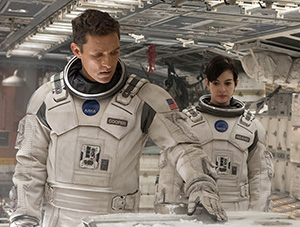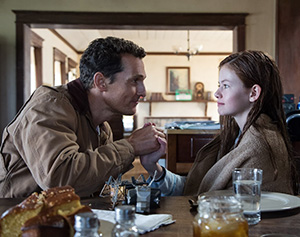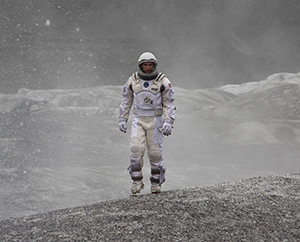
Matthew McConaughey, Anne Hathaway
Interstellar, Christopher Nolan's sweeping foray into space travel and all-American idealism, boldly goes where hundreds of films have gone before, yet feels like it's discovering the ways the moving image is able to explore our curiosity about the vastness of the cosmos. It uses state-of-the-art production values to tap into primal quandaries about humanity's place in the universe, and in so doing harkens to the dawn of cinema, where images did the heavy lifting and no emotion was too grand to match an organist's booming chords. It's reassuringly familiar and thrillingly novel, often at the same time.
For all its audacious galaxy hopping, Interstellar's brand of science fiction is intrinsically classical. In fact, much of it, its Spielbergian first hour in particular, assumes the form of an old-fashioned melodrama. There's no opening montage of how a barely-alluded-to cataclysmic event has placed mankind on a path to eventual extinction, turning parts of the planet into a massive dust bowl as its resources continue being depleted at an alarming rate. Life simply goes on for Cooper (Matthew McConaughey), engineer-turned-farmer, widower and father of two. His days as a NASA pilot are behind him, but despite a constant struggle to get by, he nevertheless encourages his children, Tom (Timothée Chalamet) and Murph (Mackenzie Foy), to never stop dreaming, to find joy in the quotidian, even if it's something as mundane as chasing after a drone through a cornfield in his truck hoping to control it.
Murph claims there's a ghost in her bedroom, and after the entity's presence becomes something Cooper cannot dismiss as being a figment of her imagination, father and daughter embark on a scavenger hunt of sorts. The trail of bread crumbs leads them to a secret NASA facility where Cooper is reunited with Professor Brand (Nolan regular Michael Caine), an old mentor who is masterminding a space mission that could find humanity a planet they could safely inhabit. Their potential ace in the hole: a wormhole that has mysteriously appeared in their solar system, about seven light years away, that would send them to another galaxy, one located dangerously close to a black hole appropriately called Gargantua.
Cooper wrestles with the decision of whether to abandon his family, and instead of lingering on the nuts and bolts of their expedition – through there's plenty of that, perhaps too much, later on – Nolan focuses on the relationship between Cooper and Murph, making the viewer feel the pain of separation and imbuing Interstellar with a wrenching sense of loss that unapologetically tugs at the heartstrings, and is all the more effective for doing so. There's an inspired transition that begins with Cooper driving away from his family, a long shot that would not look out of place in a George Stevens film, then cuts right to the spaceship launch, thus establishing a link between the film's heady space travel with the intimate domestic drama that precedes it. (What happens next is quite susceptible to spoilers, so I will tread very carefully.)

Matthew McConaughey, Mackenzie Foy
I'd taken Nolan to task in the past for the cerebral yet detached nature of his storytelling. Films like The Prestige and Inception garnered the English auteur a loyal following for the ingenious, clockwork precision of his body of work, which occasionally left this viewer feeling frustrated. In these films, feelings are an abstraction employed to propel the story forward. With The Dark Knight Rises, the rousing closing chapter of Nolan's Dark Knight Trilogy, there was a sincere attempt to engage the audience's emotions, but Interstellar, in its unabashed sentimentality, represents the first time Nolan is leading with his heart, and because of that, those larger-than-life emotions now come across as naked and true. He coaxes a fine, fully felt performance from McConaughey, who has never been so affecting.
The rest of the crew – Brand's daughter Amelia (Anne Hathaway), geographer Doyle (Wes Bentley) and physicist Romilly (David Gyasi) – are etched in broader strokes, but the sequences in which they debate which course to take as they grapple with the magnitude of their decisions lend the film a slow-burn urgency that pays off even when a reliance on dry scientific jargon in the screenplay, credited to Nolan and his brother Jonathan, doesn't always work in the film's favor. In fact, if there's a flaw in the film that detracts from what Nolan and his creative team have pulled off, is that it tries to explain too much.
It's clear Nolan is taking a cue – and then some – from Spielberg and Kubrick, splicing the latter's rigid, practical effects-driven formalism and the former's engulfing emotional richness until he arrives at a fusion of sensibilities that nevertheless bear his imprint. The Oscar-nominated filmmaker is up to his customary thematic tricks, tackling complex notions that bridge quantum physics, philosophy and ultimately a realm beyond science, and applying them to explore the passage of time away from Earth. This is probably why he feels an obligation to go into exposition overdrive, when he probably should have heeded his influences' tendency to trust in the power of their imagery. (That this film might wind up resonating with an arthouse crowd more than it does to mainstream audiences is one of the more curious ironies of this thinking-moviegoer's blockbuster.)

Photographer: Photo credit: Melinda Sue Gordon
Matthew McConaughey
Thankfully, Nolan infuses these intellectual pursuits with a transformative sense of wonder that, to me, transcends the shortcomings on which many of the film's detractors have fixated. Something was nagging at me in the days after I saw Interstellar, and I think the reason why I connected so deeply with it is the extent to which Nolan evokes iconic moments from silent films. Shots of Cooper and his children running toward their house in the middle of a dust storm bring to mind Victor Sjöström's The Wind. A bitter rumble between two characters in the middle of an arid, icy landscape may have made Tarkovsky nod in approval, but it also reminded me of the climatic mano-a-mano at the end of Erich von Stroheim's Greed.
I'm willing to bet Georges Méliès would be grinning like the Cheshire Cat if he had a chance to see this film on an IMAX screen, which, despite the changing aspect ratios distinguishing the shots filmed on 35-millimeter cameras from the ones actually shot in IMAX, is the optimal way to see the film, the better to witness an evolving filmmaker blazing a trail within himself, limited only by the reaches of his imagination as he discovers, on the broadest canvas imaginable, that love is the most precious renewable resource of all.




